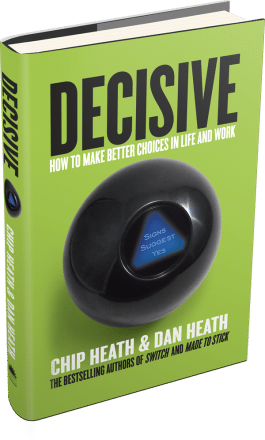Do you struggle with making decisions? Or once you’ve made a decision, do you doubt if you made the right call? If so, you’re not alone. It’s natural to have hesitancy with big decisions, or even smaller ones at times. Just because it’s natural though, doesn’t mean we can’t improve our ability to make decisions with more confidence, and with better outcomes.
A common problem that we get into when making decisions is falling into the trap of “OR” decisions. Should I take the new job opportunity OR stay where I’m at now? Do I break up with my girlfriend OR stay? Should I go on a spontaneous trip to Disney World OR not? When we view things in this way we are looking through a narrow frame. Authors Chip and Dan Heath call this one of the villains of decision making and, to describe it, they use an analogy of a spotlight.
When we look to where a spotlight is shining we see that specific area, but we don’t see everything outside of where that spotlight is shining. Similarly, we create a spotlight effect in a lot of our decisions when we view things as “OR” decisions. Is it true that there are only two options regarding our decision, or can we only see what we’re choosing to shine that spotlight on?

Things aren’t usually as black and white as we make them out to be. For example, I might see a good deal for a new car and debate buying it or not, but I’m already locking myself into a narrow frame. I don’t consider that there may be better deals elsewhere, or if I truly do, in fact, need a new car.
In their book Decisive: How To Make Better Decisions In Life and Work, Chip and Dan Heath share two ideas to help us “Widen Our Options” and avoid spotlighting. The two ideas are:
1) Opportunity Cost
2) The Vanishing Options Test

Opportunity Cost
Opportunity cost is what we give up when we choose one option over another. Put in the form of a question we can ask ourselves,
What am I giving up, with regard to my time and money, if I make this decision?
Viewing decisions through the lens of opportunity cost helps us to widen the frame of the decision. Instead of setting the spotlight on one spot and leaving it there, we move it around.
Using my car example above let’s say I asked myself, “If I buy this car what am I giving up?” Well, I’d be giving up a large chunk of money and time (researching the car, going to see it, spending money on it, etc.) I’d also have to sell my current car and go through the process of putting it up for sale, talking to potential buyers, etc.
If I don’t buy the car however, maybe I could go on a vacation with the money I saved. I could use it to invest in some continuing education courses to improve my career. Or, maybe I decide to invest it in my savings or retirement account. Even knowing there are other options to spend my money and time on can improve the decision. In addition to asking ourselves what we are giving up we can use the vanishing options test.

The Vanishing Options Test
The vanishing options test creates options through deletion. It’s generally asked as a question and could look like this:
You cannot choose any of the current options you’re considering. What else could you do?
By telling ourselves that we cannot choose a current option we’re considering, we force ourselves to widen our frame. We are forced to move that spotlight around to see more options we hadn’t considered at first.
Let’s say for example, that you’re struggling with breaking up with your significant other, or not (narrow frame). So ask yourself, “I cannot break up with this person so what else can I do?” Maybe you decide to put more time into the relationship because you realize you’ve been neglecting it and spending too much time at work. Or, maybe you realize both you and your partner’s communication hasn’t been the best, and that you need to work on that aspect of the relationship.

Now, the caveat here is that yes, maybe the best decision is to break up. Or, using my earlier example of buying a new car, maybe getting the car is the best decision. I can’t tell you for certain whether one decision is better or not, because every decision is different. What’s crucial though, is to be aware of when we are narrow framing and use one of the ideas above to widen our options.
So, what decisions are you struggling with? Is it true that you have an “OR” decision, or are there other options you may not be considering? Look through the lens of opportunity cost to examine what you are giving up by making that decision. Or, try running the Vanishing Options Test and see what alternative options pop up. You may find better options once you move that spotlight around.
Sometimes though, even when we widen our options, something still gets in the way, and that something is us. We like to always be right and do what we can to prove ourselves correct. It’s called confirmation bias and we’re all susceptible to it. There is a solution however, and you can learn how to defeat it in the next blog in this series.
Source:

Decisive: How To Make Better Choices In Life And Work by Chip Heath And Dan Heath
